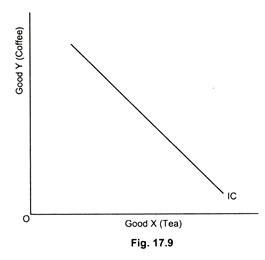Read this article to learn about the top fifteen frequently asked questions on Preference Theory of Demand.
Q.1. What are Total Utility and Marginal Utility?
Ans. Total utility of anything to an individual is the total pleasure or benefit it yields at a given period of time.
Marginal utility is the change in total utility resulting from a change in the consumption of that commodity i.e., MU = TUn – TUn-1.
ADVERTISEMENTS:
This means that MU is the difference between total utility obtained from the n-th unit and n-1th unit of the commodity.
Q.2. What is the Relation between Marginal Utility Curve and the Demand Curve?
Ans. Demand curve for a commodity is related to the marginal utility (MU) curve. MU curve is a downward sloping curve. A consumer reaches equilibrium when MU of a commodity equals its price. MU curve is a diminishing one which leads to a negative sloping demand curve.
Q.3. Define Income Effect, Substitution Effect and Price Effect.
ADVERTISEMENTS:
Ans. If the price of a commodity, tastes and preferences of a consumer, etc., remain unchanged, change in income of the consumer involves a change in satisfaction. A consumer will then be able to enjoy more (less) satisfaction as his income rises (falls). The result of this type of change is known as income effect.
Given a constant money income, a change in relative prices involves a change in the purchase pattern of the consumer. He substitutes the relatively cheaper goods for the relatively dearer ones. The change is known as the substitution effect.
A consumer’s purchase plan undergoes a change with the change in the price of one of commodities, money income remaining constant. Change in relative prices alone yields a greater or a smaller satisfaction than before because real income has changed. This change is called the price effect.
Q.4. Are Giffen goods and Inferior Goods the Same Commodity?
ADVERTISEMENTS:
Or
What is the Difference between Giffen Good and Inferior Good?
Ans. Giffen goods and inferior goods are not the same commodity. There are some commodities whose demand fall as income of the consumer rises. These commodities are called inferior goods. So, inferior goods are those goods whose income effect is negative.
On the other hand, in case of some commodities when price rises (falls) consumers buy more (less). These commodities are called Giffen goods, after the name of Sir Robert Giffen. Thus, inferior goods is an income phenomenon and Giffen goods is a price phenomenon.
Q.5. State the condition of consumer’s equilibrium in terms of utility approach.
Ans. A consumer will reach equilibrium when marginal utility from commodity X (MUX) is equal to its price (PX) i.e., MUX = PX. However, in the case of two commodities, say, X and Y, a consumer will reach equilibrium when the ratio of marginal utilities for X and Y, i.e.,
MUX/MUY is equal to the price ratio, (i.e., PX/PY)
or MUX/MUY = PX/PY.
Q.6. What is an Indifference Curve?
ADVERTISEMENTS:
Ans. An indifference curve represents different combinations of two goods that yield the same level of satisfaction to a consumer. He cannot say which combination gives him the best satisfaction. As all combinations give him same satisfaction level, a consumer remains indifferent on the curve.
Q.7. Why is an Indifference Curve Convex to the Origin?
Ans. An indifference curve is convex to the origin because of diminishing marginal rate of substitution (MRS) between two goods.
Q.8. What is Marginal Rate of Substitution?
ADVERTISEMENTS:
Ans. The marginal rate of substitution (MRS) is the rate at which one good, say Y, can be substituted for another good, say X, so that the satisfaction of the consumer remains unchanged. The slope of an indifference curve is the MRS between two goods.
Q.9. What is Price Line?
Ans. Price line shows different purchasable combination of two goods that a consumer can buy with his limited money income and given prices of two goods. The slope of the budget line is the price ratio of two goods, i.e.,
PX/PY
ADVERTISEMENTS:
Q.10. What is an Indifference Map?
Ans. A family or a set of indifference curves is called an indifference map. A consumer is indifferent between different points on an indifference curve. On the other hand, a consumer expresses his preference in an indifference map.
Q. 11. How do you Explain Consumer’s Equilibrium in terms of Ordinal Approach?
Ans. A consumer reaches equilibrium when the following two conditions for equilibrium are satisfied simultaneously. First is the equality between the slopes of indifference curve and the budget line, i.e., MRSXY = PX/PY. This condition is called necessary condition for equilibrium. Sufficient condition requires that an indifference curve must be convex to the origin.
Q. 12. What is an Income Consumption Curve?
Ans. An income consumption curve shows the various optimum levels of consumption of two goods that a consumer purchases at various levels of income, holding prices of two goods constant. Income consumption curve may be positive sloping as well as negative sloping.
ADVERTISEMENTS:
Q.13. What is Price Consumption Curve?
Ans. Price consumption curve shows various optimum consumption combinations of two goods that a consumer purchases at various prices, holding price of another commodity and money income constant.
Q. 14. Draw an Indifference Curve for which MRS is constant.
Ans. MRS remains constant when indifference curve becomes a straight line. An indifference curve becomes a straight line only when two goods are perfect substitutes (Fig. 17.9).
Q. 15. What would be the Value of Marginal Utility when Total Utility is Maximum?
ADVERTISEMENTS:
Ans. Marginal utility becomes zero when total utility is maximum.
Q.16. What are the Characteristics of an Indifference Curve?
Ans. An indifference curve has three properties:
(i) It has a negative slope,
(ii) It is convex to the origin, and
(iii) No two indifference curves intersect or touch each other.
